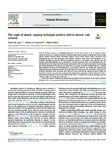The angle of attack: rapping technique predicts skill in hermit crab contests
| dc.contributor.author | Lane, Sarah | |
| dc.contributor.author | Cornwell, TO | |
| dc.contributor.author | Briffa, Mark | |
| dc.date.accessioned | 2022-04-22T12:04:10Z | |
| dc.date.available | 2022-04-22T12:04:10Z | |
| dc.date.issued | 2022-05 | |
| dc.identifier.issn | 0003-3472 | |
| dc.identifier.issn | 1095-8282 | |
| dc.identifier.uri | http://hdl.handle.net/10026.1/19047 | |
| dc.description.abstract |
Skill, the ability to perform a challenging behaviour well, has been shown to be an important determinant of success in a variety of contexts, including human sports, animal courtship and, most recently, animal contests. Because skilful movement requires precise motor control, skill is assumed to be underpinned by traits that determine these abilities. However, while these traits determine an individual's potential to perform effective movements (known as technique), this potential may not translate into skilful fighting due to interference from the opponent. Here, we investigated the relationship between technique and skill using the European hermit crab, Pagurus bernhardus. By examining the spatial distribution of shell raps, we found that, on average, technique exhibited during a ‘training’ fight predicted the level of skill displayed in a real contest. However, our results also demonstrated substantial among-individual variation in the direction of change across the two fights, with some individuals exhibiting better technique than skill and others showing the opposite pattern. Finally, we found that winners, but not losers, progressively adapted their targeting of strikes when faced with a fully functional opponent. Our results indicate that skill is a combination of innate technique and the ability to adapt to an opponent's behaviour. | |
| dc.format.extent | 55-61 | |
| dc.language | en | |
| dc.language.iso | en | |
| dc.publisher | Elsevier | |
| dc.subject | animal contests | |
| dc.subject | fighting performance | |
| dc.subject | hypoxia | |
| dc.subject | resource holding potential | |
| dc.subject | skill | |
| dc.subject | technique | |
| dc.title | The angle of attack: rapping technique predicts skill in hermit crab contests | |
| dc.type | journal-article | |
| dc.type | Journal Article | |
| plymouth.author-url | https://www.webofscience.com/api/gateway?GWVersion=2&SrcApp=PARTNER_APP&SrcAuth=LinksAMR&KeyUT=WOS:000798541700005&DestLinkType=FullRecord&DestApp=ALL_WOS&UsrCustomerID=11bb513d99f797142bcfeffcc58ea008 | |
| plymouth.volume | 187 | |
| plymouth.publication-status | Published | |
| plymouth.journal | Animal Behaviour | |
| dc.identifier.doi | 10.1016/j.anbehav.2022.02.017 | |
| plymouth.organisational-group | /Plymouth | |
| plymouth.organisational-group | /Plymouth/Faculty of Science and Engineering | |
| plymouth.organisational-group | /Plymouth/Faculty of Science and Engineering/School of Biological and Marine Sciences | |
| plymouth.organisational-group | /Plymouth/REF 2021 Researchers by UoA | |
| plymouth.organisational-group | /Plymouth/REF 2021 Researchers by UoA/UoA04 Psychology, Psychiatry and Neuroscience | |
| plymouth.organisational-group | /Plymouth/Research Groups | |
| plymouth.organisational-group | /Plymouth/Research Groups/Marine Institute | |
| plymouth.organisational-group | /Plymouth/Users by role | |
| plymouth.organisational-group | /Plymouth/Users by role/Academics | |
| plymouth.organisational-group | /Plymouth/Users by role/Researchers in ResearchFish submission | |
| dcterms.dateAccepted | 2022-01-24 | |
| dc.rights.embargodate | 2022-4-23 | |
| dc.identifier.eissn | 1095-8282 | |
| dc.rights.embargoperiod | Not known | |
| rioxxterms.funder | Biotechnology and Biological Sciences Research Council | |
| rioxxterms.identifier.project | The role of skill in animal contests: Analysis of a neglected RHP trait in fighting hermit crabs | |
| rioxxterms.versionofrecord | 10.1016/j.anbehav.2022.02.017 | |
| rioxxterms.licenseref.uri | http://www.rioxx.net/licenses/all-rights-reserved | |
| rioxxterms.type | Journal Article/Review | |
| plymouth.funder | The role of skill in animal contests: Analysis of a neglected RHP trait in fighting hermit crabs::Biotechnology and Biological Sciences Research Council |


